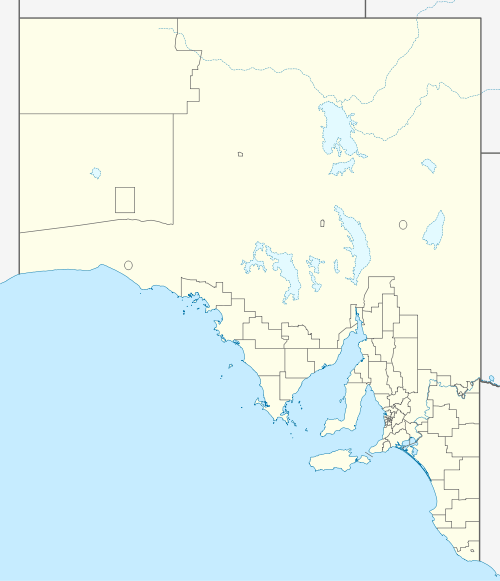Bowmans, South Australia
Bowmans (34°09′S 138°15′E; postcode: 5550) is a locality in South Australia's Mid North. At the 2006 census, Bowmans had a population of 203.[1] It is named after R and C Bowman who were "pastoralists in area."[3]
| Bowmans South Australia | |||||||||||||||
|---|---|---|---|---|---|---|---|---|---|---|---|---|---|---|---|
 Bowmans | |||||||||||||||
| Coordinates | 34°09′S 138°15′E | ||||||||||||||
| Population | 203 (2006 census)[1] | ||||||||||||||
| Postcode(s) | 5550 | ||||||||||||||
| Location | 125 km (78 mi) north of Adelaide | ||||||||||||||
| LGA(s) | Wakefield Regional Council | ||||||||||||||
| State electorate(s) | Narungga[2] | ||||||||||||||
| Federal Division(s) | Grey | ||||||||||||||
| |||||||||||||||
Traditional occupants
According to the Manning Index of South Australian History the "Nantuwwara [sic] tribe of some 25 to 30 once occupied the country from the River Wakefield, north to Whitwarta and west to Hummock Range", an area which would encompass the modern localities of Bowmans, Whitwarta, Goyder, Beaufort, Nantawarra and Mount Templeton. The term Nantuwara (or Nantuwaru) is considered to be a specific name for the northern hordes of the Kaurna people.[4] Stone implements thought to have been used by the Nantuwara people were discovered at sites adjoining the banks of the lower reaches of the River Wakefield and added to a South Australian Museum collection curated by Harold Cooper in the 1960s.[5]
Transport and industry
Bowmans is passed by the Adelaide-Port Augusta railway line and ![]()
This road was one of the early country roads in South Australia, as the Great Western Road for delivering copper from the mines at Burra to the port at Port Wakefield. It was used for this purpose from 1848 until 1857 when a railway from Gawler to Port Adelaide provided a more attractive transport option.
From 1870, Bowmans was a station on the Port Wakefield-Hoyles Plains tramway which ran inland from the port along a similar alignment to the road. This was built to 3 ft 6 in (1,067 mm) narrow gauge and initially used horses instead of steam locomotives.[6]
In 1923, the railway from Adelaide north towards Port Pirie was built as 5 ft 3 in (1,600 mm) broad gauge and crossed the Port Wakefield line at Bowmans. Both lines passed through the station but there was little infrastructure provided for transhipping goods or passengers. The break of gauge was solved in 1927 when the Western System, including the Port Wakefield railway, was converted to broad gauge as well.[7]
The Port Wakefield railway has been closed and removed. The Adelaide-Port Augusta railway line has been converted to 1,435 mm (4 ft 8 1⁄2 in) standard gauge and rerouted to bypass the station and township. The alignment of the southern entrance to the station is now the spur to service the Bowmans Rail intermodal terminal.
References
- Australian Bureau of Statistics (25 October 2007). "Bowmans (State Suburb)". 2006 Census QuickStats. Retrieved 27 July 2011.
- Narungga (Map). Electoral District Boundaries Commission. 2016. Retrieved 1 March 2018.
- "Search result for 'Bowmans, LOCB'". Land Services, Department of Planning, Transport and Infrastructure, Government of South Australia. 16 October 2008. Retrieved 1 November 2015.
- Manning, Geoffrey. "Place names: Nantawarra". Manning Index of South Australian History. State Library of South Australia.
- Cooper, H.M. (1961). "Archaeological stone implements along the lower River Wakefield, South Australia". Transactions of the Royal Society of South Australia. 34: 105–118.
- "THE PORT WAKEFIELD AND HOYLE'S PLAINS TRAMWAY, AND THE DISTRICT THROUGH WHICH IT PASSES". The Express and Telegraph. Adelaide, SA: National Library of Australia. 27 November 1869. p. 2 Edition: SECOND EDITION. Retrieved 8 December 2015.
- G F Vincent. "SOUTH AUSTRALIA'S MIXED GAUGE MUDDLE" (PDF). Port Adelaide: National Railway Museum. pp. 3–4. Archived from the original (PDF) on 28 February 2016. Retrieved 8 December 2015.